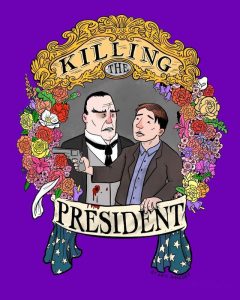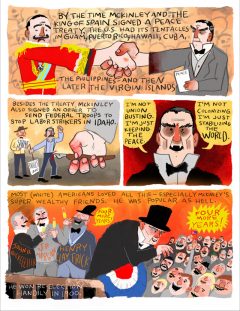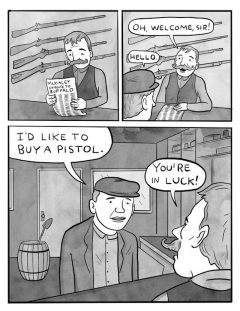Review: Killing the President (Kate Rhoades)
With the USA currently in a state of political upheaval, it’s always worth remembering that things are never as unique as they first might see. Kate Rhoade’s Killing The President is a chronicle of the assassination of US President William McKinley in 1901, and may at first glance appear be a tale from a bygone day. However its themes of economic repression, fat cats in government and a working class galvanised by populist speakers all have parallels with the present day.
 Publisher: Kate Rhoades
Publisher: Kate Rhoades
Writer: Kate Rhoades
Artist: Kate Rhoades
Price: $5 from Kate Rhoades Online Store
In Killing The President, Rhoades brilliantly chronicles the life of McKinley’s assassin, Leon Czolgosz, looking at his upbringing, his heritage and the events which saw him inspired to take, what he believed, was just action and murder the president. Frustrated by the political inaction of his peers and the disparity in wealth between the workers and foremen of the factory where he once worked, Czolgosz is inspired to take up the Anarchist cause, after being inspired by speakers in his native Ohio, as well as events happening in other countries around the world. Leon’s ‘radicalisation’ is a slow drip feed of resentment. Although he is inspired by the speakers of the time, Rhoades is very careful to not implicate any other, emphasising the ‘lone gunman’ idea, which we also see in other assassination as well as in shooting in America to this day. Leon becomes an almost sympathetic character as we follow his journey towards its righteous conclusion, which makes this path so much more tragic.
Rhoades has a wonderfully classical ‘cartoonist’ style, reminiscent of Lucy Bellwood or Erika Moen, which is perfect for this kind of story. Her characterisation of Leon is simple and cartoonish but packed with personality and detail. While the surroundings and enviros which the action is cast in, shows she has thoroughly researched every facet of the story. She balances the tight dialogue heavy panels with odd splash page as well, but also mixes the styles up with an entire chapter told in a colourful, more impressionistic style (it feels almost digitally painted compared to the hand drawn traditional cartoon style of the rest). This chapter (and subsequent epilogue) focus on the story of why McKinley was such a ripe target for assignation, as well as looking at the legacy and gives a much more hyperbolic style to these pages, feeling more like a technicolour Gerald Scarfe page than a traditional comic.
Killing the President is a really thoughtful and well-constructed read. It is a slow burner, but one with a very methodical and deliberate pace that goes to show these extreme events do not always come out of one galvanising event, rather as a result of years of accumulated oppressions and resentment. With plenty of parallels that can be drawn to the present day, although thankfully not the end result (however you could see the recent Capitol uprising as perhaps an end point for someone in a similar position.) this is a fantastic and really thought-provoking read that is well worth checking out – especially if you like the kind of historical comics we have seen published in recent years by the likes of Myriad or New Internationalist.






November 3, 2025 @ 10:16 am
Thanks for sharing. I read many of your blog posts, cool, your blog is very good.